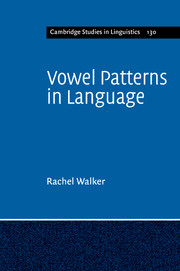Book contents
4 - Typological predictions
Published online by Cambridge University Press: 26 April 2011
Summary
Introduction
This chapter explores typological predictions made by the prominence-based licensing constraint in combination with other constraints relevant for a typology that includes licensing-driven assimilation. In OT, the typology of patterns predicted to be possible in language emerges from factorial ranking of the constraint set. In the classic conception of OT, constraints are the same across languages and there are no language-particular restrictions on inputs (Richness of the Base; Prince and Smolensky 2004). The language-particular part of grammar thus lies in the constraint ranking. Importantly, not every ranking necessarily produces a distinct pattern. In other words, multiple rankings may converge on the same outcome. As a basis for the investigation of typological predictions in this chapter, factorial typologies yielded by a particular constraint set applicable to prominence-based licensing were generated using OTSoft, Version 2.1 (Hayes et al. 2003). Licensing effects for input forms of different sizes are examined, as well as effects specific to an affix. Beyond the constraints and factorial typologies relevant for assimilation patterns, some main interactions of the prominence-based licensing constraint with other faithfulness constraints are also investigated.
The constraints considered in the factorial typologies for licensing are instantiations of the ones used in §3.5 to illustrate selection of the three licensing configurations: License, Ident, *Duplicate, and CrispEdge. In addition, two positional faithfulness constraints are considered. Positional faithfulness constraints enforce identity of input–output mappings in particular positions deemed to be prominent.
- Type
- Chapter
- Information
- Vowel Patterns in Language , pp. 64 - 88Publisher: Cambridge University PressPrint publication year: 2011



